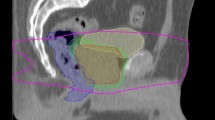Background and Purpose:
Radiotherapy plays an important role in the management of prostate cancer. Epidemiological data indicate a small but sinificant risk of radiation-induced leukemia after radiotherapy which might be related to the high mean bone marrow dose associated with radiotherapy of prostate cancer. The purpose of the study was to investigate the relation between the mean bone marrow dose and unstable chromosome aberrations in peripheral blood lymphocytes in patients undergoing conformal radiotherapy for prostate cancer as a possible indicator of risk. Endometrial cancer patients were also included for comparison.
Patients and Methods: Nine patients, six with prostate cancer (60–73 years old) and three with endometrial cancer (61–81 years old) treated with radiotherapy were included in the study. The non-body spaces inside the pelvic bones were outlined on every CT slice using the treatment planning system and mean doses to the bone marrow calculated. Blood samples of the patients were obtained at different times before, during and at the end of treatment. Lymphocytes were cultured in the usual way and metaphases scored for dicentric aberrations.
Results: 46 samples from nine patients were obtained. The mean number of metaphases analyzed per sample was 180 with a range from 52 to 435. The mean bone marrow doses for prostate cancer patients ranged from 2.8 to 4.2 Gy and for endometrial cancer patients from 12.8 to 14.8 Gy. The aberration yield increased with the planning target volume and the mean bone marrow dose.
Conclusion: The yield of dicentric aberrations for prostate cancer patients correlated closely with the mean bone marrow dose albeit the induction of dicentrics occurred in mature T lymphocytes most of which were probably in transit through the irradiated volumes. Therefore, the observed relationship between dicentrics and mean bone marrow doses are indirect.
Hintergrund:
Bei der kurativen Behandlung des Prostatakarzinoms besitzt die Radiotherapie einen wichtigen Stellenwert. Andererseits weisen epidemiologische Daten auf ein erhöhtes Leukämierisiko nach Strahlenbehandlung hin. Ziel der vorliegenden Untersuchung war die Analyse des Zusammenhangs zwischen akkumulierter Knochenmarkdosis und der Häufigkeit dizentrischer Chromosomenaberrationen in peripheren Blutlymphozyten von konformierend bestrahlten Patienten mit Prostatakarzinom. Patientinnen mit Endometriumkarzinom wurden zum Vergleich in die Untersuchung eingeschlossen.
Patienten und Methode: Neun Patienten, sechs mit Prostatakarzinom (Alter 60–73 Jahre) und drei mit Endometriumkarzinom (Alter 61–81 Jahre), bei denen das Behandlungskonzept eine konformierende Strahlentherapie vorsah, wurden in die Untersuchung eingeschlossen. Knochenmarkvolumen und mittlere Knochenmarkdosis wurden nach Kontuierung der Markräume in jedem CT-Schnitt am Bestrahlungsplanungssystem berechnet. Zu bestimmten Zeitpunkten vor, während und nach Abschluss der Strahlentherapie erfolgten die Entnahme von Blutproben der Patienten und die Anfertigung von Chromosomenpräraten für die konventionelle zytogenetische Analyse. Die Häufigkeit dizentrischer Chromosomenaberrationen wurde bestimmt.
Ergebnisse: 46 Blutproben von neun Patienten wurden untersucht. Die mittlere Anzahl der analysierten Metaphasen pro Probe betrug 180 (Bereich 52–435). Die mittlere Knochenmarkdosis von Patienten mit Prostatakarzinom lag zwischen 2,8 und 4,2 Gy und fünf Patientinnen mit Endometriumkarzinom zwischen 12,8 und 14,8 Gy. Die Häufigkeit dizentrischer Chromosomenaberrationen korrelierte mit dem Planungszielvolumen (PTV) und der mittleren Knochenmarkdosis.
Schlussfolgerung: Die Häufigkeit dizentrischer Chromosomenaberrationen bei bestrahlten Prostatakarzinompatienten ist deutlich geringer als bei Endometriumkarzinompatientinnen. Sie korreliert mit der mittleren Knochenmarkdosis, obwohl die Aberrationen in reifen T-Lymphozyten induziert wurden, die sich vor allem im Transit durch die bestrahlten Volumina zum Zeitpunkt der Bestrahlung befunden haben. Deshalb halten wir diese beobachtete Korrelation für indirekt.
Similar content being viewed by others
Author information
Authors and Affiliations
Additional information
Received: April 28, 2001; accepted: October 26, 2001
Rights and permissions
About this article
Cite this article
Gershkevitsh, E., Hildebrandt, G., Wolf, U. et al. Chromosomal Aberration in Peripheral Lymphocytes and Doses to the Active Bone Marrow in Radiotherapy of Prostate Cancer. Strahlenther Onkol 178, 36–42 (2002). https://doi.org/10.1007/s00066-002-0886-y
Issue Date:
DOI: https://doi.org/10.1007/s00066-002-0886-y




